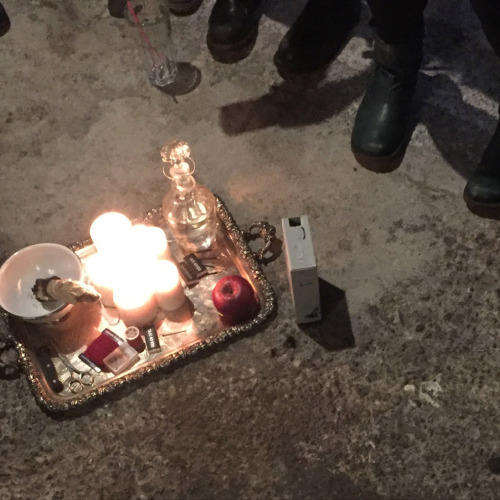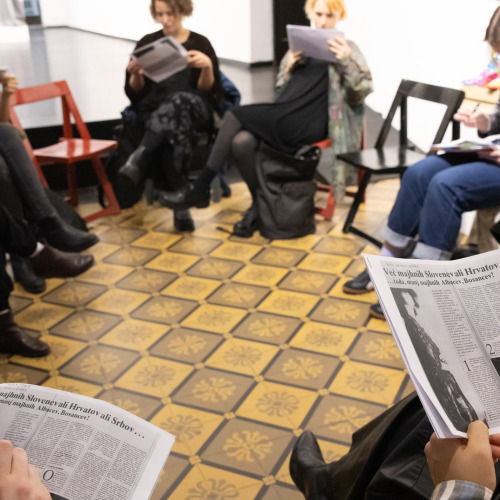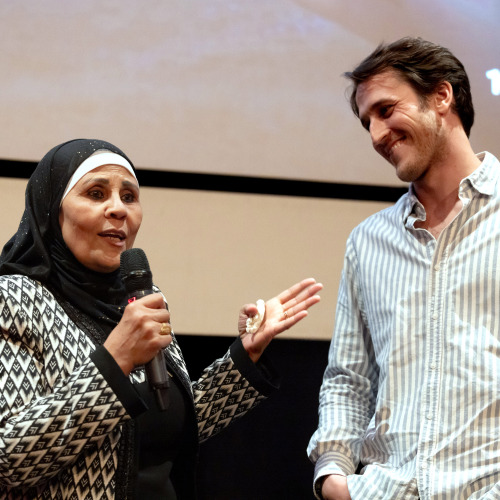
Decoding Resilience by SIDE
Decoding Resilience is the title of the community-based (participatory) artistic practice conceived by the group SIDE, consisting of Samar Zughool, Behnaz Aliesfahanipour, Safe Saad and Sammar Al Kerawe, and presented during the May Event Cycle of the City of Women Association. The results and the documentation of the performative actions and their reflections in the form of public workshops, around which the project revolves, were put on display as a multimedia exhibition at the Španski borci cultural centre. The approach of the group SIDE is complex but clearly structured into several performance parts that intertwine and sometimes begin to multiply—as one would expect from a practice that involves community-based artistic engagement and actively adapts in the process to the changing state of a multi-member group and its desires, needs, fears and goals.
The central themes highlighted by the authors include the dynamics of power in social contexts based on ethnicity and gender, which are rooted in their own experiences, and the ways in which these are positioned within global geopolitical developments and thus within the history of colonialism and the contemporaneity of neoliberalism. They address segregation and discrimination based on social stereotypes, racial and gender profiling. They criticise binary divisions and the established discourse on the integration of migrant women. Their approach is a mix of activism and performing/visual arts. From performance to the techniques of Theatre of the Oppressed, from documentary use of photography to collaging appropriated images from mass media, original illustrations and accompanying commentaries. The public workshops conducted as part of the project delve into the sphere of unconventional pedagogical work and therapeutic methods based on artistic practices that look back to the work of Paulo Freire and Augusto Boal. Their moves are supported by research and literature review developed and articulated through theoretical writing by Samar Zughool but are based on shared actions and reflections. The title of the project is by no means coincidental, but rather references that which has been important for the development of the model for Community-Based (Participatory) Artistic Practices of Decoding Resilience.
Decoding presupposes the disclosure of the code and is the basis of communication, which is based on the mutual understanding of the actors involved. Although the term code has been semantically linked to programming languages since the advent of computers, when used as a hypernym it actually refers to all tools used to transfer information from one medium to another. Whether in the form of sound or speech, gesture, writing, image or long-range information transfers using electric field waves, a correct interpretation of the code is a prerequisite for successful communication between living or non-living beings. Living beings learn the code through observation and repetition. And although we are constantly learning new codes, the initially learned codes are those that are conditioned by the process of the socalled socialisation, i.e., the first gesticulations and behaviours that are later supplemented by language in the form of speech or gestures. There are thus codes of behaviour at the level of the body and language that are socially conditioned and belong to the realm of culture. By sociological standards, culture is both learned and common—presumably to all who have learned it.
In the context of education for marginalised and oppressed groups, Paulo Freire, the author of the classic work, Pedagogy of the Oppressed, proposed the concept of decoding not only as an understanding of the means of communication, but as a process of critical analysis of the complexly coded social situations in which communication takes place. The tool he used was material objects such as photographs or texts that allow subjects to describe abstract situations they are confronted with through the object, using concrete experiences from their actualities. Thus, Freire understands decoding as a shift from the abstract to the concrete, where the former is replaced by a critical perception of the latter. He argues that by actively exploring and making statements about reality, it is also possible to appropriate it.
Resilience is a term that describes coping and adapting to a negative situation, the result of which is the strengthening of the one who has coped or adapted. It is used in various fields, from psychology to business to pop culture. For example, resilience can be found in strategic documents dealing with migrations, which plan integration policies, though strengthening is often used here in conjunction with empowerment, which is also the ultimate objective of such programmes. Resilience in gender politics in a neoliberal context is discussed at length in Angela McRobbie's book Feminism and the Politics of Resilience, an Essays on Gender Media and the End of Welfare. Between the binary division of the perfect and the imperfect image of a woman, she locates resilience as a quality of those who navigate between the two states, while overcoming difficulties along the way becomes the so-called success in the context of the economic assumptions of the capitalist market model. Her understanding of resilience in an otherwise Anglo-Saxon environment has been a key influence on resilience as perceived by the group SIDE in their practice, using the image of the “top-girl” to construct the image of the “topmigrant” who “effortlessly learns a foreign language, gets a job and successfully assimilates into a new environment”.
As Zughool astutely points out, inequality exists in the naming itself, with an expat being someone who comes from the “developed West” and “contributes” to the economy, and a migrant being someone who comes from the “underdeveloped South” and “feeds off”. SIDE are also critical of the term empowerment in the context of mainstream integration policies, pointing out that in this kind of process, power relations often remain the same and the mechanisms of their perpetuation can be covertly reproduced even in the work of female cultural workers—an otherwise seemingly accepting and aware spectrum of society—especially when the project is aimed at empowering marginalised groups. Decoding Resilience therefore proposes a shift from empowerment to acknowledgment, which is seen as a community-based process.
“-We need migrant workers in our country. -You do not need a job, you need a man. -Migration is good for the economy. -Will you clean my shoes, and the house? -Your uniform is like mine. I come from Kosovo. I work in Slovenia in construction. -No you cannot be from Iran. Make a DNA test. You are too white to be from Iran. -Ve ste čefurke? A ste iz Bosne? -Can I put you live on facebook while you clean my shoes?” [1]
Decoding Resilience began when Samar, Behnaz and Sammar donned blue workers' uniforms and took to the streets of Slovenian cities with a cardboard sign that read “Clean your shoes for free”. On a symbolic level, they illustrated the social expectations they felt others had towards them as migrants based on their ethnicity: to work, to take on tasks that are considered inferior, physically demanding or unwanted by everyone, and to be underpaid for their work. Safa sat next to them as an outside observer of the process, sketching what she saw while the action was photographed undercover by Jelena Radusinović. The performers also secretly recorded the sound, as every trace of the unpredictable action was important for later analysis. As can be seen from the recorded comments on their performance, they did not even need a uniform to demonstrate gendered social expectations.
The group SIDE called the first phase of the decoding process “Veil of Ignorance” in reference to John Rawls' theory of social justice, according to which people should be able to imagine the world more justly by distancing themselves from their personal circumstances and the biases attached thereto. After each performative action, the group discussed in detail what had happened on the street, how each of them had seen it and what emotions they had felt about it. The analysis, translated into different media, was applied to the only artefact that was extracted from the action with the permission of those present and participating—the photographs of the freshly polished shoes. By collaging the shoes of the authors of the statements into contexts that propagate or enable such beliefs, they placed the local reality they had experienced firsthand into a global context. In this way, a shined shoe became a symbolic kick; to museums that normalise colonial violence by displaying artefacts acquired in foreign lands, to Western politicians, both past and present, and their patriarchal gesticulations, to people on the street who had uncritically displayed their undersurface racist beliefs with off-the-cuff comments. But there were also shoes that became a symbol of solidarity—with workers, with women.
As part of Decoding Resilience, SIDE also organised two public workshops—“The Shades of Accountability” took place before the exhibition and contributed to the future artefacts, while “Embodying Decoloniality” was part of the programme accompanying the exhibition in the May Event Cycle. Both placed great emphasis on movement in relation to our inner processes and focused on reflecting on the possibilities of redefining concepts such as citizenship or identity and their embodiment. Bodies are important carriers of memory, which often cannot be put into words and can find a sense of security in familiar gestures. Once learned, it is difficult to forget. The process of forgetting takes as long as the process of learning, and their simultaneous action overwrites old habits with new ones. But there always remains a trace of the former, reminding us of the possibility of change. Decoding processes take place that lead to an understanding of where our beliefs and intertwining desires and fears come from. It is important to share these processes, to speak them out loud, to show them—only in this way can we own them and control them according to our wishes.
Through a multi-layered process of decoding resilience, the group SIDE has primarily questioned how we actually want to understand community-based artistic practices? Based on the experience that brought predefined hierarchies rather than real change to collaborative processes of “co-creation”, they propose resilience decoding as a model for inter-creation; to abolish the eternal status quo and live amongst (inter-) each other rather than with (co-) each other. The change in terminology stems from the question of whether we really want to merely co-exist with each other or also share the space between us.
[1] Selected statements of the participants of the street performance, interpreted by the group SIDE with their own voices and played as an audio recording in the exhibition Decoding Resistance as part of the May Event Cycle of City of Women.




